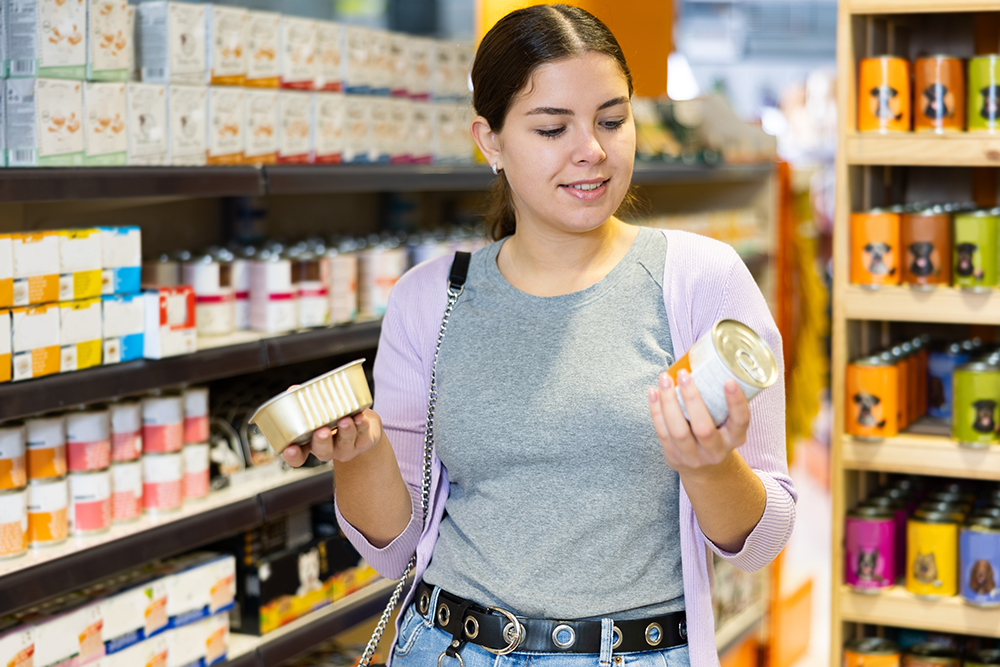Click to Skip Ahead
Note: This article’s statistics come from third-party sources and do not represent the opinions of this website.
With today’s consumers enjoying better education and more resources to improve their dogs’ quality of life, manufacturers are ramping up their efforts to meet our constantly evolving standards. Now, owners have more options than ever, and they’re only getting better.
Everything from grain-free foods to raw diets has representation on the market, each evolving with buyer trends. Fads come and go, capturing the height of consumer consciousness at the time. What’s hot in the dog diet industry this year? We’ll help you keep up with an ever-changing landscape by exploring 10 dog food trends in 2024.

The 10 Dog Food Trends in 2024
- Fresh dog food sales have risen 86.5% since 2021.
- Grain-free dog food sales only grew by 4.8% in 2023.
- A quarter of owners buy toppers for their dog’s food.
- Private-label pet food sales increased by 25.6% in 2023.
- U.S. dog food sales by volume dropped 5.2% in 2023 despite higher dollar sales.
- 32% of consumers switched to lower-priced dog foods in 2023.
- More than three-quarters of consumers are willing to pay more for food suited to their dog’s needs.
- Two-thirds of dog owners are open to trying alternative proteins.
- Over two-thirds of pet food buyers want treats or toppers with functional benefits.
- The global vegan dog food market will grow by 12% in 2024.

Dog Food Types and Formats
1. Fresh dog food sales have risen 86.5% since 2021.
(CoBank)
Dry dog food is still king in overall sales, but the recent interest in fresh food options is becoming harder to ignore. Since 2021, fresh dog food dollar sales have risen 86%. With increasing product launches overtaking the market, that impressive sales growth will only continue in 2024.
Fresh dog foods use minimal processing, preservatives, or additives, making them as nutritious and palatable as possible and giving dogs more with every bite. Manufacturers use gently cooked ingredients in their foods, which typically need freezing or refrigeration.
Experts predict the fresh pet food market to experience a 28.12% increase in 2024 and a nearly 30% CAGR through 2028.
The surging sector outpaces dog food’s overall growth of an expected 4.6% CAGR through 2032. Although shelf-stable foods will still be the standard, frozen and refrigerated commercial products will continue their advance toward mainstream acceptance in 2024.

2. Grain-free dog food sales only grew by 4.8% in 2023.
(Nielsen IQ)
The grain-free fad has slowed in recent years as more dog owners became skeptical about its effects. Alongside the growing concern around grain-free foods and their connection to dilated cardiomyopathy, the limited health benefits and increasing price difference drive many consumers to traditional grain-in options.
Although grain-free foods saw a 4.8% YoY increase by April 2023, that growth was far from the 9.6% increase they saw in 2018. Meanwhile, non-grain-free products enjoyed a substantial 18.7% boost in that same period.
3. A quarter of owners buy toppers for their dog’s food.
(Appetizer)
The humanization trend is leading more pet parents toward diversified diets to give their dogs a varied experience and well-rounded nutrition. We don’t eat the same food for every meal, so why should our dogs?
Unfortunately, creating unique meals carries a high cost and low practicality. To indulge their dogs in a way that makes sense, pet parents are instead moving to toppers.
Toppers include freeze-dried food, bone broth or other liquids, or wet food that goes on top of the dog’s regular kibble. It’s a less pricey way to finish off meals and add more unique flavors. Balancing the need to save money with the desire to give dogs a more human-like dining experience, 25% of American dog owners used toppers in 2023, a significant increase from the 13% of owners that did so in 2019.

Dog Food Purchasing and Inflation
4. Private-label pet food sales increased by 25.6% in 2023.
(PLMA)
Inflation and a desire for premium products are making dog food purchases more challenging for caring pet parents. As a way to cut costs without compromising quality, more consumers are moving to store brands.
Private labels have been outpacing national brands in innovations in recent years. Sales of private-label pet foods increased 25.6% in 2023, which is the highest YoY gain among all product categories. Store brands still only account for 3.3% of the market share, leaving plenty of room for growth in 2024.
5. U.S. dog food sales by volume dropped 5.2% in 2023 despite higher dollar sales.
(CoBank)
Inflation has been a salient issue in nearly every product category in the last few years, and its impact is apparent when comparing recent pet food volume growth versus dollar sales.
Dog food dollar sales increased by $1.56 billion from 2021 to 2022 and another $1.23 billion in 2023. Yet, despite the increased revenue, the amount of dog food sold declined in 2023, returning to 2021 levels. Most of the decline has been in wet dog food sales, a format that typically commands higher prices.

6. 32% of consumers switched to lower-priced dog foods in 2023.
(Packaged Facts)
With rising pet food prices, many consumers are looking for alternatives to their preferred products. In 2023, a third of dog food buyers switched to lower-priced options, helping private labels make impressive gains.
Still, another 34% of dog owners also made jumps to more expensive brands, indicating the value modern customers are putting on high-quality foods.
7. More than three-quarters of consumers are willing to pay more for food suited to their dog’s needs.
(PETS International)
The change in buying habits to lower-priced foods may be a cost-saving measure, but it doesn’t mean pet parents are opting for lower quality. According to a PETS International survey, 76% of respondents were willing to pay for more expensive food if it was better for their dogs’ unique needs.
The survey found 60% of consumers looked for high-quality products, while only 42% noted price as a top criterion.

Dog Food Innovations
8. Two-thirds of dog owners are open to trying alternative proteins.
(PETS International)
Beef is still the number one protein choice for consumers, though more dog owners may be open to unconventional sources to fulfill their pets’ nutritional requirements. The PETS International survey found that 65% of consumers in 2023 were open to alternative proteins in their dog food.
Eggs, algae, and vegetables were the top preferred sources. Even insects are gaining attention, as 48% of dog owners noted they would consider them, though Americans are less open to the idea than other global consumers.
9. Over two-thirds of pet food buyers want treats or toppers with functional benefits.
(Mintel)
Treats aren’t just a fun training reward anymore. In 2024, 69% of pet food buyers are interested in treats and toppers that offer functional benefits, like improving digestion, nourishing the skin and coat, or boosting joint health.
Consumers are putting a higher value on getting the most nutritious snacks possible, treating them as a crucial part of the dog’s daily diet and not a sparingly given reward.

10. The global vegan dog food market will grow by 12% in 2024.
(The Business Research Company)
As more consumers focus on animal welfare, environmental sustainability, and improved physical health, plant-based diets are gaining steam. Now, dog owners are getting their pets in on the trend.
Vegan dog food has come into vogue in recent years, and in 2024, the global market is expected to grow 12% from the prior year, bringing it to just over $17.5 billion. Experts predict the market will maintain an 11.5% CAGR to 2028, raising it to more than $27 billion.
Frequently Asked Questions About Dog Food Trends
What Is the Driving Trend in the Dog Food Market in 2024?
Humanization has been a growing trend since the 2010s, and 2024 shows no signs of it slowing. Younger generations are redefining family structures, with their treatment of pets serving as an apt indicator of new perspectives. Many prioritize their dogs’ health over their own, a point becoming apparent in the growing number of pricey human-grade food options.
“Pet parents” are replacing traditional “owners.” Dogs have become family members that modern caregivers frequently humanize through their language, routines, and purchase decisions. In many ways, dogs receive consideration almost identical to children.
Pet parents want the best for their dogs, pushing them towards expensive diets touting features like “all-natural,” “grain-free,” or “organic” ingredients. Alongside the nutritional aspects, products are improving the dining experience for dogs and owners.
Ingredients are easier to understand, while numerous brand lines and innovative formats make dog meals and treats more similar to human foods.

How Are Pet Food Manufacturers Embracing Sustainability?
Sustainability is top-of-mind for today’s consumers, helping brands find new avenues to make (and advertise) their mark. Dog owners want products that are better for the environment and human and canine health.
- Utilizing alternative proteins (e.g., black soldier flies, mealworms, wild game)
- Creating recyclable and biodegradable packaging
- Using locally sourced ingredients
- “Upcycling” food by-products
- Reducing water use
- Creating more energy-efficient production processes
- Replacing meat-heavy ingredients with organic, plant-based alternatives
From sourcing to production to distribution, investing in sustainability is smart business. Companies use this for differentiation to become more attractive to discerning dog owners. In 2024, product labels will add more marketing messages calling out these efforts.

Conclusion
Modern owners care deeply for their dogs as equal family members, and they’ll go to many lengths to give their pets the complete nutrition they need. Pet parents are more knowledgeable and motivated than ever. Despite rising costs, trends in innovation, humanization, and premiumization will mean better dog food options for doting pet parents in 2024 and beyond.
Featured Image Credit: AYO Production, Shutterstock










